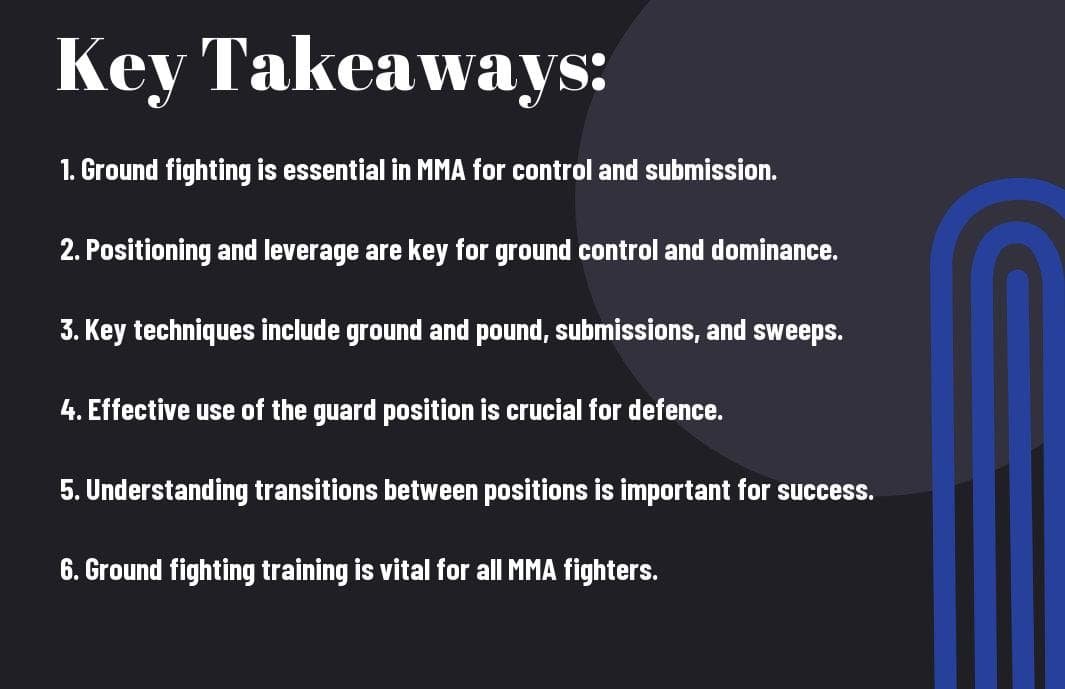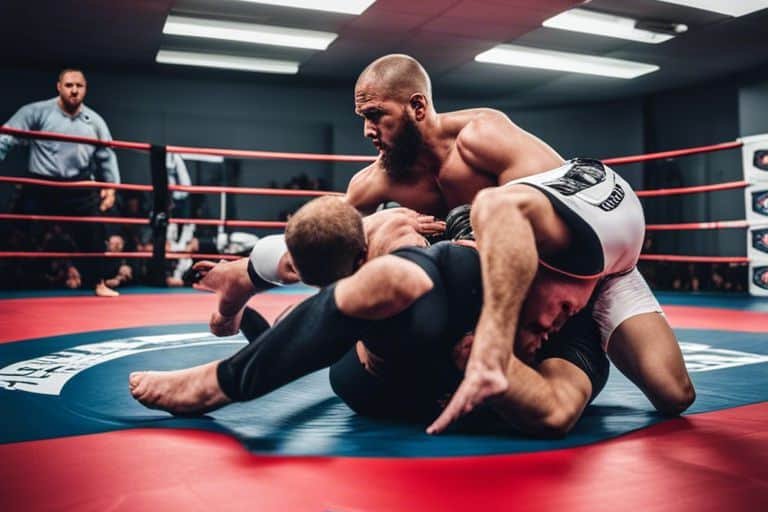Are you looking to improve your ground fighting skills in MMA? Ground fighting is a crucial aspect of mixed martial arts that can often determine the outcome of a fight. Understanding the basics of ground fighting, including positions, transitions, and submissions, is essential for any aspiring MMA fighter. In this blog post, we will explore the fundamental principles of ground fighting in MMA and how you can improve your technique to become a more effective fighter.
Key Takeaways:
- Positioning is crucial: In ground fighting in MMA, proper positioning is vital for gaining control over your opponent and executing effective techniques.
- Control the hips: Controlling your opponent’s hips is key to preventing them from escaping and allowing you to set up submissions and strikes.
- Utilise leverage and technique: Using leverage and effective technique allows fighters to generate maximum power and control while minimizing their own vulnerability.
- Stay active: Constant movement and maintaining aggression are essential in ground fighting to secure dominant positions and wear down opponents.
- Striking is still important: Ground fighting in MMA involves a combination of grappling and striking, so fighters need to be proficient in both aspects in order to be successful.

Fundamental Positions in MMA Ground Fighting
When it comes to ground fighting in MMA, understanding the fundamental positions is crucial. These positions provide the foundation for effective control, submission, and striking techniques on the ground. By mastering these positions, you can navigate through various scenarios and gain the upper hand in a fight.
Guard
The guard position is one of the most fundamental and versatile positions in MMA ground fighting. It involves being on your back while using your legs and hips to control and defend against your opponent. From the guard, you have the ability to launch a variety of offensive and defensive techniques, such as submissions, sweeps, and strikes. It’s a position that allows you to control the distance and angle of your opponent, making it a powerful tool in your arsenal.
Mount
Mount position is a dominant position in MMA ground fighting, where you are on top of your opponent and straddling their torso. From mount, you have the advantage of being able to strike with both hands, as well as apply powerful submission holds. This position allows you to exert a significant amount of control over your opponent, making it one of the most dangerous positions for them to be in. It’s an advantageous position that can lead to a quick finish if utilised effectively.
Side Control
Side control is a position where you are perpendicular to your opponent, controlling them on the ground while pinning their torso with your body weight. From side control, you have numerous options for advancing your position, setting up submissions, or transitioning to a more dominant position. This position provides you with the ability to immobilise your opponent and execute a range of effective attacks, making it a highly advantageous position for you in a fight.
Back Mount
Back mount is a dominant position in MMA ground fighting, where you are on your opponent’s back with your legs wrapped around their waist. From back mount, you have the ability to apply a variety of choke holds, as well as control your opponent’s movement and defence. It’s a position that allows you to launch a relentless attack while staying out of range of your opponent’s strikes. Securing back mount can significantly increase your chances of securing a submission victory in a fight.
Essential Ground Fighting Techniques
When it comes to ground fighting in MMA, there are several essential techniques that you need to master in order to be effective. These techniques include takedowns and takedown defense, submission moves, sweeps and reversals, as well as ground and pound strategies. Understanding and practising these techniques will help you to gain the upper hand when the fight goes to the ground.
Takedowns and Takedown Defense
Takedowns are a crucial aspect of ground fighting in MMA. Being able to take your opponent down to the mat not only puts you in a dominant position, but it also allows you to control the pace and direction of the fight. On the other hand, having solid takedown defence is equally important. This will enable you to keep the fight standing and prevent your opponent from taking you down, giving you the opportunity to utilise your striking skills.
Submission Moves
Submission moves are an integral part of ground fighting in MMA. From chokes and joint locks to leg locks and arm bars, having a diverse arsenal of submission moves can make you a formidable opponent on the ground. These moves can help you to force your opponent to tap out or even secure a victory via submission, making them a crucial aspect of your ground fighting skill set.
Sweeps and Reversals
Sweeps and reversals are essential for turning the tide of a ground fight in your favour. Being able to reverse your opponent’s dominant position or execute a sweep to gain the upper hand can be game-changing. These techniques require timing, precision and quick thinking, but they can give you the opportunity to transition into a dominant position and launch your own offensive attacks.
Ground and Pound Strategies
Ground and pound strategies involve utilising ground fighting techniques to control your opponent and then deliver powerful strikes from the top position. This approach allows you to capitalise on the advantage of being on top, and it can cause significant damage to your opponent. With a combination of effective control and explosive striking, you can wear down your opponent and potentially secure a victory by knockout or referee stoppage.
Ground Fighting Strategies and Training
When it comes to ground fighting in MMA, having a solid strategy and effective training is essential for success. In this chapter, we will discuss various strategies and training techniques that can help you improve your ground fighting skills and dominate your opponents on the mat.
Developing a Ground Game Plan
Having a well-thought-out ground game plan is crucial for your success in MMA. This involves understanding your strengths and weaknesses, as well as those of your opponent. By identifying your strengths, you can build a game plan around them, while also working on improving your weaknesses. Visualising different scenarios and practicing specific techniques will help you stay composed and focused during ground engagements, allowing you to effectively execute your game plan.
Drills for Improving Ground Control and Submission Skills
Improving your ground control and submission skills is essential for dominating your opponent on the ground. Incorporating specific drills into your training routine can help you develop a strong foundation in these areas. Focus on drills that improve your positioning, transitions, and submission set-ups. By regularly practising these drills, you can enhance your ability to control the fight on the ground and increase your chances of securing a submission victory.
The Role of Cardio and Strength in Ground Fighting
Cardiovascular endurance and strength play a crucial role in ground fighting. Ground engagements can be physically demanding, and having good cardio and strength will give you a significant advantage over your opponent. Incorporate high-intensity interval training, strength training, and functional exercises into your workout routine to improve your overall physical conditioning. A strong and enduring body will enable you to maintain control and pressure on the ground, increasing your chances of outlasting your opponent.
Mental Preparation for Ground Engagements
Mental preparation is just as important as physical training when it comes to ground fighting. Developing a strong mindset and mental resilience can give you the confidence and composure needed to face the challenges of ground engagements. Visualise different scenarios and practice mental exercises to stay focused and composed during a fight. By training your mind, you can approach ground fighting with a calm and collected demeanour, enabling you to make decisive and effective decisions in the heat of battle.
Conclusion
Now that you have learned the basics of ground fighting in MMA, you are better equipped to understand and appreciate the tactical and technical aspects of this crucial component of the sport. By mastering the fundamental principles of positioning, submissions, and ground-and-pound techniques, you can significantly enhance your effectiveness in this phase of the fight. Additionally, understanding the importance of maintaining a strong base and body control will allow you to effectively defend against your opponent’s attacks and execute your own offensive strategies. With consistent practice and dedication, you can become a more proficient ground fighter and ultimately improve your overall performance in MMA.
FAQ
Q: What is ground fighting in MMA?
A: Ground fighting in MMA is the aspect of mixed martial arts where opponents engage in combat on the ground, using various grappling techniques to gain dominance and control over their opponent.
Q: What are the key techniques used in ground fighting?
A: Key techniques used in ground fighting include submissions such as chokes and joint locks, ground and pound striking, and positional control to secure advantageous positions.
Q: What are the fundamental positions in ground fighting?
A: The fundamental positions in ground fighting include the mount, side control, guard, and back control, each offering different opportunities for control and attack.
Q: How important is ground fighting in MMA?
A: Ground fighting is crucial in MMA as it allows fighters to effectively control and dominate their opponents, and it is where many fights are won or lost through submissions or ground and pound striking.
Q: What are some common ground fighting strategies?
A: Common ground fighting strategies include looking to secure dominant positions, working towards submissions, and using ground and pound to inflict damage on the opponent.
Q: What are the risks of ground fighting in MMA?
A: Risks of ground fighting in MMA include being susceptible to submissions and strikes from the opponent, as well as the possibility of being pinned or controlled in a disadvantageous position.
Q: How can I improve my ground fighting skills in MMA?
A: Improving ground fighting skills in MMA involves training in various grappling techniques, drilling positions and transitions, and sparring with partners to simulate real fight scenarios.



